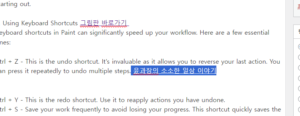Absolutely! Here’s an in-depth guide for beginners to quickly master the essentials of Microsoft Paint, a basic yet versatile graphic editing tool included with Windows operating systems. This guide will focus on five key shortcuts and features that make it easier to use, even for those just starting out.

1. Using Keyboard Shortcuts 그림판 바로가기
Keyboard shortcuts in Paint can significantly speed up your workflow. Here are a few essential ones:
Ctrl + Z – This is the undo shortcut. It’s invaluable as it allows you to reverse your last action. You can press it repeatedly to undo multiple steps. 윤과장의 소소한 일상 이야기
Ctrl + Y – This is the redo shortcut. Use it to reapply actions you have undone.
Ctrl + S – Save your work frequently to avoid losing your progress. This shortcut quickly saves the file you are working on.
Ctrl + A – This selects everything on your canvas. It’s useful when you want to move all elements together or apply changes to the entire canvas.
Ctrl + C and Ctrl + V – Copy and paste are fundamental functions in any editing software. Use these to duplicate selections or move content from one part of the canvas to another.
2. Mastering the Selection Tools
Selection tools are crucial for editing specific parts of your image without affecting others:
Rectangular Selection: This tool allows you to select a rectangular area in your image. Anything within this rectangle can be copied, cut, or edited.
Free-Form Selection: Sometimes called the ‘Lasso’ tool, it lets you draw a freehand selection around any irregularly shaped object to isolate and manipulate it.
When using selection tools, remember that once a section is selected, you can move it by simply dragging it with your mouse. Right-clicking within the selection also brings up options to cut, copy, or delete.
3. Colors and Brushes
Paint offers a variety of brushes and colors which are easy to use and mix:
Brush Tools: The basic brush tool can be used for freehand drawing. There are several brush styles, such as oil brush, watercolor, and calligraphy. Experimenting with these can enhance the texture of your drawings.
Color Palette: The default color palette provides a basic range of colors. You can customize any color by clicking on ‘Edit Colors’. Here, you can create virtually any color you need for your projects.
4. Using Layers
While Paint does not support layers in the way that more sophisticated graphic programs like Photoshop do, you can simulate the effect of layers using multiple images:
Open Multiple Windows: You can open multiple instances of Paint and use one as a background and others for different elements of your image.
Copy and Paste: Use these functions to move elements from one Paint window to another, arranging them to create a layered effect.
5. Saving and Exporting Files
Understanding how to save your files in different formats can be very helpful:
File Types: Paint allows you to save images in several file types such as JPEG, PNG, BMP, and GIF. Choose JPEG for a good balance of quality and file size for photos. Use PNG for images that require transparency.
Using ‘Save As’: To save a project in a different format, use the ‘Save As’ option under the File menu. This allows you to keep your original file unchanged while creating a copy in another format.
Conclusion
These five key features and shortcuts are just the beginning of what you can do with Paint. Practice is essential—spend time experimenting with these tools, and you’ll find yourself becoming more proficient and creative with this simple yet powerful program. Whether you’re creating simple graphics, editing photos, or just doodling, knowing these basics will enhance your ability to use Paint effectively.